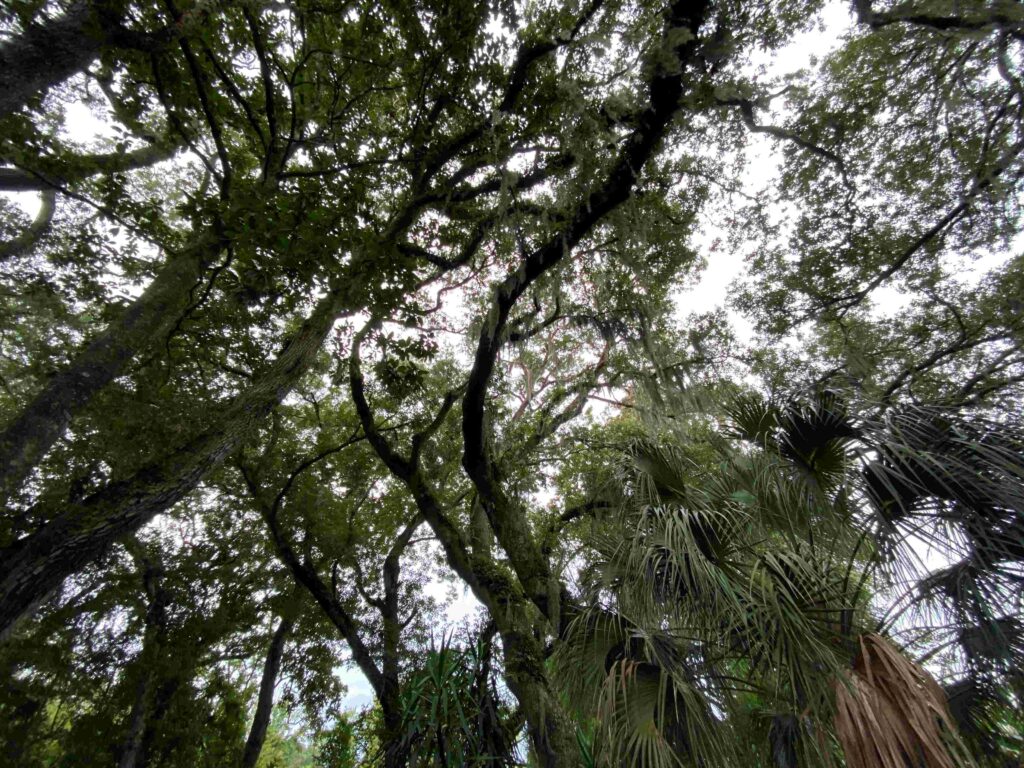By Pat Foster Turley, Ph.D.
August 26, 2021
Pat’s Wildways: Nature Watching from the Porch

It was a fine Sunday morning in summer, not yet too hot or crowded at the beach and my friend Susan and I were all set. I had my beach chair and umbrella in the trunk, my bathing suit and cover-up on, and drove over to Susan’s to pick her up. “But do you want to come in first and say “Hi” to Sunny? “Sure”.
Susan and I both have manipulating cats and whenever we visit each other we check in with them too. So, I went out to her screened in back porch, her “cattery,” where Sunny was hanging out. And then we heard the hawks.
Susan’s home backs up to the Egans Creek Greenway under a canopy of mature live oak and hickory trees, and a view of the sky over tall palms, banana trees, and other lush vegetation sunken into a ravine behind her house. Hawks and other birds are common enough here. But this time was different. There were at least three hawks screaming at each other as they flew from one tree to another and then out of sight. Mating season was long over, so maybe this was some offspring asserting their voice. I guess we will never know.
But right after all this commotion the barred owls repeated their own call, “Who cooks for you?” a number of times, a couple of owls at least, and calling in the daytime? What gives? We settled onto chairs to learn more. Soon flocks of small songbirds flew into the canopy. They were some sort of warbler, I think, but we couldn’t get a close look at them, but interesting still.
We admired those banana trees deep in the valley and wondered about them. So we Googled it. We learned there are many different types of bananas grown in north Florida, some reaching heights of 25 feet or so, and apparently this is one of them. Susan’s bananas are tough to harvest due to their inaccessible location and the height of the bananas that develop, but the times she and her husband Flip have succeeded in cutting them, they did taste fine, if not so worth the considerable effort.
By this time the day was warming up, the parking lots at the beach were no doubt filling, and, frankly, it just seemed like too much trouble to cart all our stuff to a crowded beach when lots of natural excitement was happening right in front of us, here on Susan’s porch.

So, out came the drinks and snacks, and we settled in to more nature watching, accompanied by Sunny the cat who tolerated our presence in “her” porch. At one point we did move from our chairs to tour her yard, but I ended that pursuit quickly. Although Flip had carefully removed any poison ivy from the yard, I soon spotted my nemesis, those lovely Virginia creeper vines that some people, myself included, are highly allergic to. I had one period of weeks that my chest and arms were covered with severe poison- ivy- like weeping itchy rashes after I carried a load of these vines from my yard. Never again. Now, when I see Virginia creeper I more than creep in the other direction, far away from them.
Back on our porch chairs again, we heard the distinct (to me) calls of a blue jay. But Susan, who watches nature often, had never seen a blue jay in her yard, and we didn’t see one this time either. But I do have them occasionally at my bird feeder only a few miles away, so I remained convinced. Other small birds flitted in and around the forest canopy, a pair of pileated woodpeckers settled into a nearby tree, and we carefully surveyed the live oak branches to see if we could find any orchids hidden in the resurrection ferns.
We never did make it to the beach that day, but, luckily for us, the beach is always there just moments from our homes. The next day I received a text from Susan with a photo of a blue jay feather that landed in her back yard. Susan told me that according to one online spiritualist, “the feather of a Blue Jay is a sign of silver lining and optimism amid trying times, which means it symbolizes hope and energy.” I don’t know about this, but I do know that some hours with a friend watching nature does this for me.
And maybe next time we will actually go to the beach.
Pat Foster-Turley is a zoologist on Amelia Island. She welcomes your nature questions and observations. [email protected]

I too, often hear the blue jays. One of the few distinctive bird calls I learned growing up on Long Island.
Unfortunately, they seem to prefer the high tree canopy rather than the ground or lower shrubs, so I rarely see them in my yard where the cardinals and brown sparrows are more prevalent.